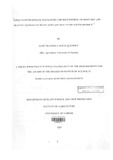| dc.description.abstract | Pulses are important for food and income earning for most households. However diseases and
pests such as root rot and bean fly, can be overcome using soil fertility amendments and seed
priming by enhancing the plant growth vigour. Research has identified some pulse varieties with
both pest and disease tolerance and locally available fertilizers in the region to improve both the
plant nutrition and soil nutrient status.
Western Kenya is an important pulse production area in this study, three field experiments were
conducted in Aldai division, Nandi south district, in four sites to determine effects of phosphate
fertilizers and seed priming on root rots and bean fly in beans and lablab during the short rains of
2008. These were planted in the four sites along a soil fertility gradient in a randomized complete
block design (RCBO), laid out in split plot arrangements and replicated three times. Three legume
varieties tested were lab lab (cv. Rongai), KK8, and GLP2 planted and evaluated on root rot and
bean fly damage. Controls consisted of plots without phosphorus and without primed seeds. Data
collected included emergence percentage, population at harvest, root rot and bean fly incidence
and severity, biomass at flowering stage, days to 50% flowering, grain yield and yield
components.
Varietal differences and soil fertility levels significantly affected root rot and bean fly damages in
both beans and lab lab. Root rot and bean fly damage was generally high in low fertility sites.
Significant grain yield increase with the increasing soil fertility levels was observed in all sites
with the supply of phosphate fertilizers. Priming improved plant survival percentage in low
fertility sites by 30% compared to high fertility sites. It was observed that application of
Phosphorous fertilizer and priming generally reduced the bean/lab lab plant mortality, and
mortality rates were lower in high fertility compared to low fertility sites. Application of
phosphate fertilizer enhanced lablab plant biomass and 100 seed weight, irrespective of seed
priming. There was a higher lablab grain yield in high fertility site (Koibem), compared to low
fertility sites (Kapkarer), when P fertilizer was applied.
Therefore, the field study confirmed that adequate soil nutrients in the soil are important for crop
tolerance to both root rot and bean fly damage. TSP application on KK8 beans gave the highest
yields with least pest and disease losses in all sites. Soil fertility measures and soil amendments
could lead to higher yields of legumes in degraded soils after years of conversion from forestland
to cropland. The results showed various parameters measured in legume varieties had different
variable effects depending on age of plant, soil nutrients of the site and other prevailing
environmental factors. Seed priming might not necessarily improve grain yield in high rainfall
areas unlike in the low rainfall areas, as the soil water available could be enough to facilitate
germination of the seeds. | en |

